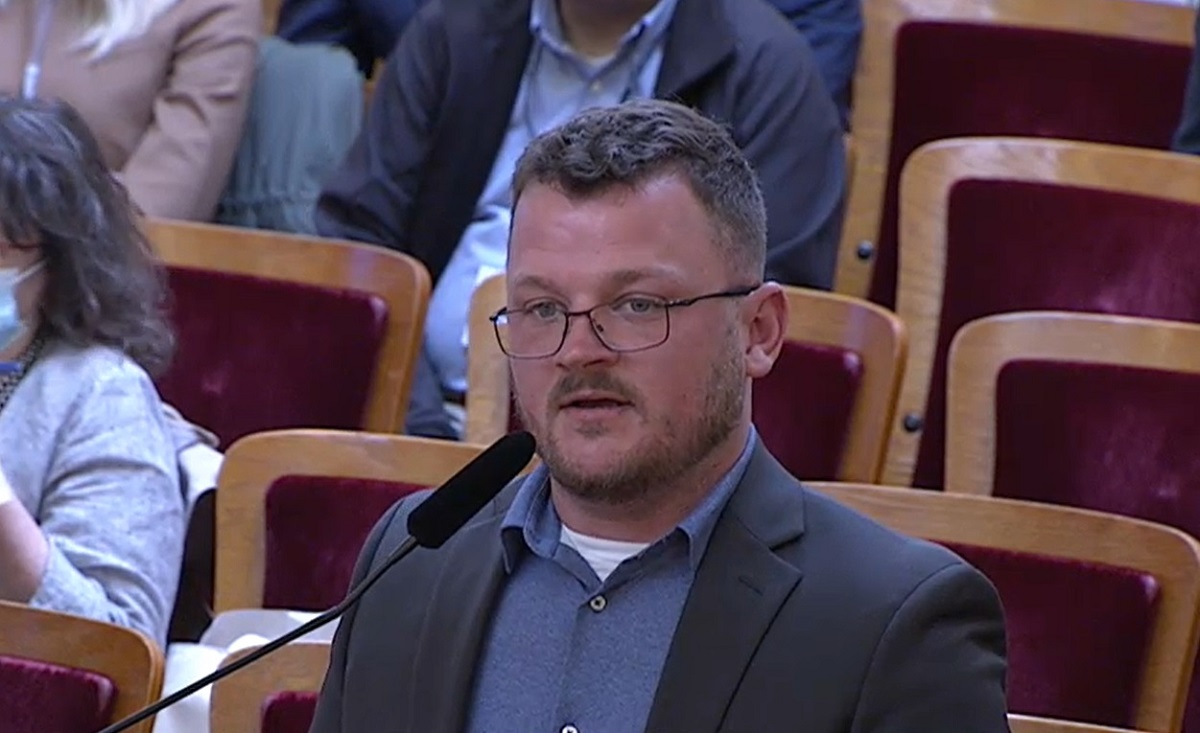Updated May 12, 3:30 p.m.
The city agencies involved in approving housing may soon enter the digital age, ditching paper site permits and allowing building applicants to submit plans via an online portal.
The Planning Commision and the Building Inspection Commission squeezed onto a shared dais Thursday to hear the new plans, which would not take effect until this summer at the earliest.
“It’s very regularly reported in the news how long our permit process takes,” said Michael Christensen, principal planner for the Permit Center. By reworking the system, he said, new housing could be approved more quickly – a pressing need in San Francisco, where limited housing availability has contributed to eye-watering costs.
Today’s meeting was an informational session to gather feedback on the proposals and did not involve a vote. The Planning Department and the Department of Building Inspection, which worked jointly on the project, intend to submit legislation for the overhaul in the coming months.
Commissioner Joel Koppel said that the proposed changes could also combat corruption in the permitting process, a thorny issue that has dogged the department for years. In 2020, department head Tom Hui was suspended over a decade of misconduct, and multiple building inspectors have been investigated for cronyism, bribery, and fraud.
“We’ve had people in the past that have gravely abused our systems,” said Koppel. “I don’t think we should ever leave room for one more Rodrigo Santos, one more Bernie Curran.”
Santos is a permit expediter and one-time head of the Building Inspection Commission who has pleaded guilty to charges including bank and wire fraud. Curran is a former building inspector who pleaded guilty in a bribery scheme last year.
“The word that I would use to describe this improvement: Hallelujah,” said former Planning Commissioner Dennis Richards, who called in during public comment. In 2020, Richards sued the Department of Building Inspection after permits on his house were revoked in apparent retaliation for allegations he made about corruption in the department. The city settled his case for $1.8 million last year.
“It’s transparent. It’s customer friendly. It’s automated and it provides accountability,” said Richards. He described the current process, by comparison, as a “total clusterfuck.”
It is not currently uncommon for applicants to wait years for site permit approval. Local architect Serina Calhoun said that even minor projects like single family home extensions can take “two to five years” to get approved. Another architect said during public comment that his application for a foundation permit took seven and a half years.
If signed into law, these new plans could help the city reach its ambitious and state-mandated target of building 82,000 new units over the next eight years. Hitting this goal would require tripling San Francisco’s average rate of new construction.

The new proposal involves simplifying how “site permits” are managed. Site permits are a kind of umbrella permit that allow work on construction sites to get started in phases before every detail of a given project has been approved. They are used to construct the vast majority of new buildings in San Francisco.
Under the new plan, these would be restyled as “development review permits.” Applications would be made online through the Planning Department’s Accela portal, rather than in person at the Permit Center. And only one application, to the Planning Department, would be needed, whereas currently applicants need to file with both Planning and Building Inspection.
“It’s almost like shopping online,” said Christensen of the portal. “You fill out your application, you attach your documents, you submit your plans.”
Accela is already used by Planning for other kinds of applications, said Christensen, so it could be adapted to accept permits without extra cost to the city. Once an application has been submitted, multiple departments involved in examining it — Planning, Building Inspection, Public Works — would be able to access the documents via the same, shared portal.
“It’s really surprising how much city process currently happens over email,” said Christensen. This means that permits can easily fall through the cracks and it often falls to applicants to complain and get the process moving again, he said.
In contrast, using a shared system for tracking applications would mean that the applicant and the various departments could see clearly the status of any given permit. A shared system could also be used to automatically assign each department a 30-day deadline to complete their part of the review; no such deadlines currently exist.
Another benefit of a shared digital system, Christensen added, is that they could track exactly where permits were getting held up. They could see if particular departments were slow to respond to permits, for instance, or if certain parts of applications often contained mistakes. That could then be used to prod departments into action or update guidance for applicants.
Under the new plan, each department would be expected to review plans concurrently, rather than one at a time. The departments would review applications using checklists shared with applicants beforehand. A member of the planning department would oversee this process and would consolidate feedback for the applicant, should their project need any tweaks.
“There will be one human that you can contact who’s working on your project,” said Elizabeth Watty, director of current planning at the Planning Department. “They can either help resolve your question or make sure that somebody else responds to your question.”
Multiple commissioners questioned the extra workload that may fall upon planning staff. Planning commissioner Kathrin Moore additionally raised concerns that moving to a digital system could mean nuanced requirements becoming “lost in translation,” because there would be less direct contact with real people at the start of an application.
Though the proposed changes may speed housing production, the permitting system is only one part of the puzzle. On Monday, Mayor London Breed issued a three-month update to her “Housing For All” plan; site permit reform was one of eight key improvements. Housing construction is also tied up inextricably with market forces, which are not optimal for development right now.
Still, commissioners felt that the new plans were timely and were broadly optimistic that a revamped permit system would help the city when development begins to pick up.
“This is a major improvement in how we review and approve major construction projects in San Francisco,” said Building Inspection Director Patrick O’Riordan. “It’s a smarter way of doing business that is going produce housing in less time, for less money and using a more rational process.”
“Right now we’re in our economic downturn,” said Rachel Tanner, president of the Planning Commission. “We know that the world of planning and building is very cyclical. We move with the markets. And the markets, right now, are retracting.”
“This is the time to retool,” she said. “To think about how we do things: How we can do things differently and how we can do things better.”



Let the buyer beware: digital records can be more easily altered than paper records. Let the hack commence.
As a Building Professional,
I have worked for Sunnyvale as a building inspector , in training.
Later I worked for the City of Daly City
In a field building inspector. For two years
Hoping to be able to gain a pension, that was not forthcoming. So I applied to the San Francisco Building Department.
I was hired in2002, first as a field Inspector, then transferred to Code Enforcement .
I took the role in the hearings as the investigator , of the Code Violations .
Presenting the building Departments case.
I saw lots of new inspectors get hired, and witnessed the grooming process unfold. It took a senior inspector to bring in allies, with Questionable certifications
To do his bidding. Where these men came from is another story.
I worked alongside people that were unqualified for the job.
“Giving it away” is the reference to just signing the card without inspection.
Sitting in a car and having the job card brought to it.
I retired In 2016 after 12 plus years.
On my 70th birthday.
I walked out.
I sleep good every night knowing I tried to make things safer. And some things were out of my control. As you see the now a few convictions of the low hanging fruit ,
There are others that fled before the storm. And those who of course seem above the law. Who pull the strings.
Can’t wait for these updates. I’ve been working through the current system for the past 2 years and every step w the city (historic review, site permit, and now the building permit) have taken way longer than expected. We have had to complain multiple times to make progress. And to my understanding, we’re getting through the system quickly! The current system is completely broken for average residents.
Makes sense, it is 2003 after all.
Indeed, they’ll be creating a web portal for end users!
Just make sure you can’t update records at will like the last database they were using
DK,
I believe that you mean to say that one “can’t update records anonymously and surreptitiously” — in order to conceal corrupt and criminal behavior — as is presently the case with regards to DBI’s standalone system.
On the Planning Dept’s “Accela” system, all changes can be tracked directly to the party making the changes.
DK,
I believe that you mean to say that one “can’t update records anonymously and surreptitiously” as is presently the case with regards to DBI standalone system — in order to conceal criminal behavior. On the Accela system, all changes can be tracked directly to the party making the changes.
DK,
I believe that you mean to so that one “can’t update records anonymously and surreptitiously” as is presently the case with regards to DBI standalone system — in order to conceal criminal behavior. On the Accela system, all changes can be tracked directly to the party making the changes.